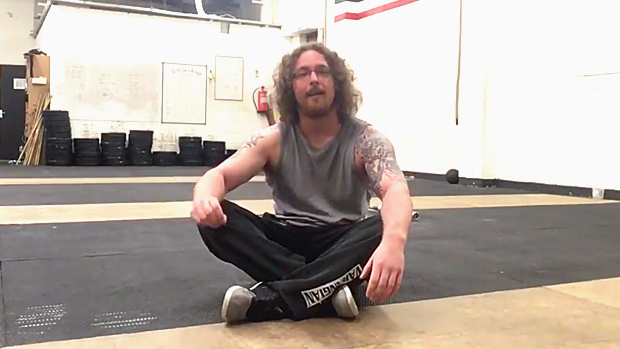Back in 2005 I wrote my first article on High Frequency Training (HFT), a system of training a muscle group or exercise more than four times per week, and it created quite a buzz in the industry.
I think the concept of HFT struck a chord with lifters and word spread quickly for three reasons.
First, intuitively it makes sense that training more often will yield faster results, provided your central nervous system (CNS) can recover. Second, most guys want to do more than they're currently doing. Give them the thumbs up to train calves or biceps five times per week and they're as giddy as Kirstie Alley in a doughnut shop.
Third, and most importantly, HFT works!
I'd already spent four years experimenting with HFT when I wrote that article, and since then I've written many more on the topic. I keep adding to my body of work because I'm constantly tweaking my original HFT parameters as I work with more people at various levels of the fitness spectrum.
Some guys want to add more muscle; others want to finally be able to knock out 20 pull-ups, while other guys want to improve local recovery. Different goals require a different approach.
So now it's time for my latest, most effective and user-friendly version of HFT that will add new muscle wherever you want it.
I started experimenting with HFT in 2001 after experiencing an awakening while watching the Alexis Brothers break every sacred fitness principle in Cirque du Soleil's Mystere.
What they were doing, especially with regard to training frequency and recovery, shouldn't have been possible – with or without steroids. And man do those dudes have incredible physiques, replete with muscle that's as strong as it looks! Just one of their performances would hurl most of us into rhabdomyolysis. But these guys perform 10 shows per week! Indeed, they're the embodiment of HFT.
Why does HFT work? It's based on a very straightforward concept: some muscles need a lot of volume to grow; significantly more than what you're currently exposing them to. But there's a limit to how much volume you can stuff into one workout, or even one day.
Therefore, you must step back and look for ways to increase your weekly volume. Boxing for 60 minutes once each week won't give you great deltoids, but boxing for 30 minutes six times per week definitely will. Arnold turned his pathetic calves into one of his best body parts when he started training them six times per week.
I can give dozens and dozens of other real-world examples and you probably can, too. The bottom line is that HFT should be a component of your hypertrophy program. It's not a stand-alone principle, but it's an important spoke in the wheel. When you get it right, HFT stands tall as one of the best ways to build new muscle fast.
HFT is also based on another principle: increasing the volume of an exercise in a systematic way will make your muscles grow. With the HFT parameters in this article you'll increase your training volume each week because you'll be able to perform more reps of a particular exercise by upregulating neurological and muscular processes.
Importantly, the progression you'll experience isn't linear. You won't add reps with every workout. There will be some stock-market like fluctuations. And just like the stock market, all that matters is you finish significantly higher than you started.
I don't stake any claim in creating the simple concept of training more often to build muscle. Arnold figured it out, and many other lifters probably did long before him. But HFT has been altered, modified, and sometimes watered-down to the point where it's no longer anything more than just training an exercise a bunch of times per week in hopes that something magical will happen.
I know how Dr. Tabata must feel when he sees a YouTube video of droll fitness folk doing shoulder presses for 20 seconds followed by 10 seconds of rest labeled as the "Tabata Method."
Over the years I've seen numerous adaptations of HFT protocols. Some make sense; others miss the target completely because of a fundamental misunderstanding of the principles it takes to get the right ratios of volume, intensity, and recovery.
The appeal of HFT is huge, so it's easy to think that it'll work equally well for building strength, adding muscle, burning fat or increasing your speed. Therefore, it's important to know what new principles I've learned since my last article. With this new information you'll learn how and when you should use HFT, and when you shouldn't use it.
So let's get started.

Now, let's start with the goods. HFT is ideal for the following three goals.
Fitness buffs want to be able to crank out 20 body weight pull-ups, yet most of them can't. The same is true with 100 push-ups or 20 single leg squats. If you're weaker, your goal might be to achieve 20 full range-of-motion dips for the first time. Basically, I'm talking about adding reps to any exercise that only requires your body weight for resistance. If you currently fall short of your rep goal, this info is for you.
There are typically two schools of thought when it comes to boosting your reps with a body weight exercise. I'll use the pull-up for the sake of this discussion. The first school looks at the muscle groups involved in the pull-up and sets up a workout of exercises that target each muscle group.
Since a pull-up challenges the forearms, biceps, deltoids, lats, rhomboids, lower/mid traps, and core, you'll need a few sets of each exercise for those seven muscle groups. So you're looking at 14-21 sets of isolation exercises on top of everything else you're doing in the workout. That's fine if you don't have a job and your recovery and nutrition are stellar. However, even if you do have those luxuries, it's still not ideal. Why?
From a neurological perspective it's wise to make the muscles contract in a way that's specific to the exercise. The pull-up, or any other movement, requires a precise firing combination during different phases of the movement. This is called a motor pattern.
The lats aren't always maximally involved throughout a pull-up. Neither are the biceps or rhomboids since they fire at different rates at different joint angles. A straight-arm lat pulldown is a good exercise but it doesn't challenge the lats exactly like a pull-up does. This, by the way, is why leg curls have little to no impact on boosting your sprinting performance.
But don't misinterpret what I'm saying. When the goal is maximal strength or hypertrophy with strength, you must do exercises that strengthen key muscle groups.
The glute-ham raise is great for boosting your squat, and the lying triceps extension is effective for increasing your bench press. However, when the goal is to increase the number of reps with a specific exercise, it's imperative to develop the nervous system with practice – perfect practice.
Getting big and strong for the sake of being big and strong isn't the same as achieving 20 pull-ups for the first time.
The second school of thought relies on the law of repetition, which states that practicing an exercise more often will boost your performance. It does so faster than isolation exercises because you're training the motor pattern, not just the muscles.
Each time you repeat the motor pattern it makes that neurological blueprint stronger as a result of feedback and feed-forward mechanisms. This is why it's essential to always do each rep with perfect form. Only perfect reps enhance the motor pattern, and that's key to elevating your reps. Even a slight shift in technique (swinging or kicking your legs) will not enhance the ideal motor pattern as effectively as doing it with perfect form.
This brings me to an important part of boosting your reps with any body weight exercise: you must be able to perform at least six perfect reps right from the start.
I frequently hear statements such as, "I can only do two pull-ups so I'm using your HFT plan to increase them." It won't work. You'll end up doing crappy reps that will, in turn, enhance the wrong motor pattern.
Here are the parameters for adding reps to a body weight exercise. Again, you must be able to perform at least six perfect reps for HFT to work.
- If you can do 6-9 total reps of an exercise: perform two sets of as many reps as possible five days per week on a 3 on/1 off and 2 on/1 off cycle for four weeks. Here's how the weekly plan looks if you start on Monday.
- Monday, Tuesday, Wednesday: 2 sets of as many reps as possible
- Thursday: off
- Friday-Saturday: 2 sets of as many reps as possible
- Sunday: Off
- If you can do 10 or more reps of an exercise: perform one set of as many reps as possible six days per week on a 6 on/1 off cycle for four weeks. It'll look like this:
- Monday-Saturday: 1 set of as many reps as possible
- Sunday: Off
At the end of four weeks take 3-4 full days off from the exercise and retest your maximum rep performance. It's common to double your reps in one month.
Why the discrepancy between methods? It's about intensity and recovery. The closer you are to your one-repetition maximum (1RM), the more recovery you'll need due to CNS fatigue.
That's why you need two days off per week if your starting point is closer to your 1RM. If you can only do six pull-ups it's obviously much more taxing on your CNS than a body weight exercise you can do for 25 reps.
Being farther from your 1RM allows you to train more frequently without overtraining. If you can do 60 push-ups, and your goal is 100, you could easily do one set every day for three weeks straight and probably add a rep each day. This is not the case with exercises that put more stress on your CNS. Those exercises require more recovery, hence an extra day of rest each week.
What about lifting speed? When the goal is endurance, you don't need to worry about it. You can't add endurance to high-threshold motor units so there's no need to tap into them. Lift with a moderate tempo and crank out as many reps as possible.
Most of the people who add HFT into their program are looking to add size to a specific muscle group – calves, biceps, forearms, etc. It works awesome, if you do it at the right time.
When should you add HFT to your program? When you're on a muscle-gaining nutrition cycle. In other words, you must be getting plenty of calories and sleep. HFT and the Velocity Diet don't mix.
You'll need to add 250 extra calories per day when you incorporate a HFT exercise into your current routine. This is on top of the extra calories you should already be feeding your body on a muscle-gaining diet.
Where the calories come from aren't as important as the fact that you're getting them. Importantly, you only need those extra calories on the days you're adding the HFT exercise into your routine. This is a simple way to take advantage of calorie cycling, an excellent nutritional strategy for building muscle while staying lean.
So let's say you're doing three full-body workouts per week on Monday, Wednesday, and Friday. For muscle growth you need more volume than you used for simply adding reps to an exercise. You'll take the parameters that I mentioned above and add one set so it looks like the protocol below.
- If you can do 6-9 total reps of an exercise: perform three sets of as many reps as possible five days per week on a 3 on/1 off and 2 on/1 off cycle for four weeks. Here's how the weekly plan looks if you start on Monday.
- Monday, Tuesday, Wednesday: 3 sets of as many reps as possible
- Thursday: off
- Friday-Saturday: 3 sets of as many reps as possible
- Sunday: Off
- If you can do 10 or more reps of an exercise: perform two sets of as many reps as possible six days per week on a 6 on/1 off cycle for four weeks. It looks like this:
- Monday-Saturday: 2 sets of as many reps as possible
- Sunday: off
At the end of four weeks take 5 full days off from the exercise and take measurements.
Now, let's say you want a bigger chest so you choose push-ups as the HFT exercise. You can currently do 22 reps. Perform two sets of as many reps as possible on Monday-Saturday, in addition to your full-body workouts on Monday, Wednesday, and Friday.
On the days that you're performing your regular workout, put the push-ups at the beginning of the workout to take advantage of the pre- and post-workout nutrition that should be a part of your nutrition plan. Rest a couple of minutes between each set of push-ups to ensure that you're getting complete recovery.
I know what you're thinking, "Can I do this HFT method for more than one exercise?" You can if it's an exercise that doesn't work any of the same muscles, and it mustn't be taxing on the CNS.
In other words, you should be able to do at least 10 reps of the second body weight exercise, or use a weight that allows 10 reps of a single-joint exercise, right from the start. A perfect addition would be calf raises with just your body weight, or biceps curls with a 10RM.
Combining pull-ups with dips is tough to pull off, but many guys do it. I'm not saying you shouldn't do it, but be certain your nutrition and recovery are spot on for the month.
Here's a simple principle to remember: the easier an exercise is on your CNS, the better your chances of success when doing HFT for more than one exercise. If you choose three exercises they must all be single joint, such as a lateral raise, biceps curl and standing calf raise. For multi-joint exercises such as pull-ups and dips, two exercises are the limit.
For hypertrophy it's imperative to perform each rep as explosively as possible in order to recruit all your muscle fibers.
Now you know how to add reps or muscle to a woefully inadequate body part. In the next installment you'll learn the 3rd Goal, the times when it's not appropriate, plus a program to add muscle to the most notoriously stubborn muscle group: the calves.





